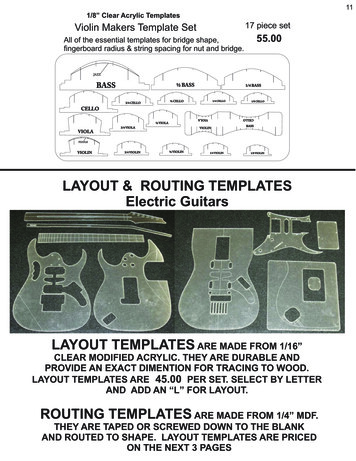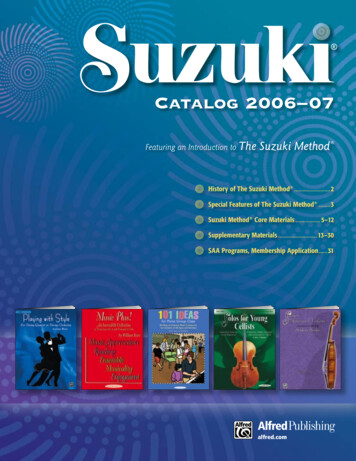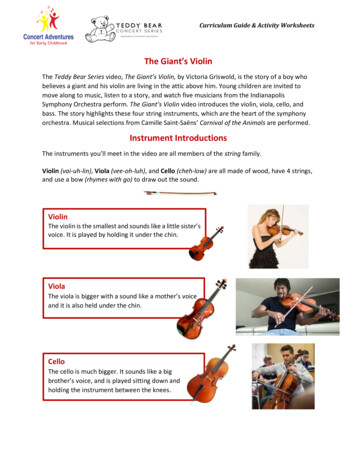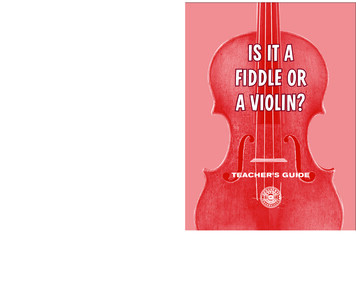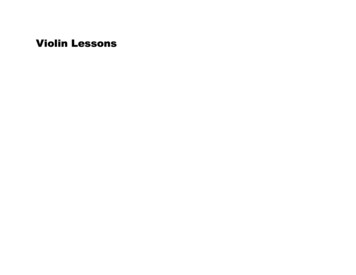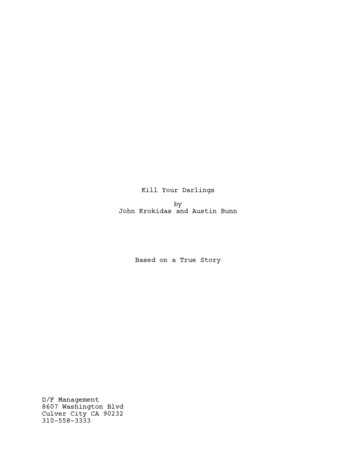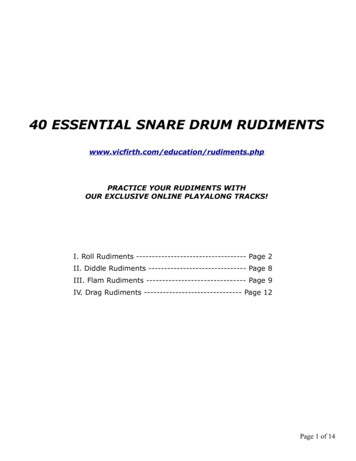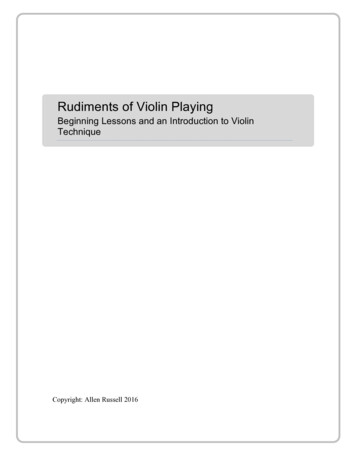
Transcription
Rudiments of Violin PlayingBeginning Lessons and an Introduction to ViolinTechniqueAllen RussellCopyright: Allen Russell 2016
Note: Many of the exercises and language in this manual are not ofmy own invention, and plenty others are. I’ve made no attempt to“cite” or differentiate the origins of any of this material since, overthe years, the ideas have organically grown into each other throughuse in lessons. Since the purpose of this manual is to provide quick,easy, and ordered access to the material I teach, it seems pointless totry. Paul Roland, Mimi Zweig, Otakar Ševčík, Shinichi Suzuki, EdKreitman, Jerry Franke, and Dr. Bernard Zinck have all informed myphilosophy and teaching methods directly and indirectly.2
Table of Contents:1. Starting Violin Lessons p. 5A. Deciding on the Right Size InstrumentB. Taking Care of the InstrumentC. AccessoriesD. Parts of the Violin2. The Bow p.8A. Parts of the bowB. BowfingersC. “Tigerclaw, Duckbill”D. Bowhold hand shape/Making bowholdo Ideas for Combating TensionE. Bowhold exercises- to Check the Posture of Hold and to Demonstrate MechanicsF. Shoulder Bowing- For Patterns and to Check Posture3. Holding the Violin p. 12A. StanceB. Putting up the violinC. Playing PositionD. Position of Heado Exercise for Holding Violino A Note on PostureE. Flying Pizzicato4. Left Hand p.15A. First PositionB. Basic Left Hand PostureC. Rolling PizzD. Left hand PizzE. Putting Down/Lifting Fingers- Playing the Releaseo Exercise for Putting Down Fingersi. Posture Checklisto Lifting Fingerso Playing the ReleaseF. Shifting Exercise 1- the Shifting Mechanism (arm) and Maintaining Hand Shapeo Posture ChecklistG. Tapping Exercise/tempoH. Shifting Exercise 2 - positionsI. Pieces for Left Hand pizz (String Academy)o Ants, Long Song5. Using the Bow on the Violin p. 22A. Square Arm When Bow is at Middle/Level of Elbow to WristB. First Touching Bow to Stringo Hover bow- heavy pinkie- give bow to the stringo Pronation/supinationo A Note on Bowfingers MotionC. Silent Rolling Bow Across Strings From ShoulderD. Silent Bow Placements-Points of bow- Tip, Middle, Balance Point, Frog3
E. Bow Circleso Up Bow and Down Bowo Contrary Body MotionF. Chicken Wing, Little Elbow—Stop BowsG. Keeping the Bow Straighto Kreisler Highway/Sounding PointsH. Double StopsI. Rolling ChordJ. Moving the Bow on the String. Martelé, Detache, Legato strokesK. First Rhythms- counting along to a metronomeo Mississippi Hot Dog, Grasshopper (long short short)o Guiding the Student’s Bow for ThemL. Bowfingers at the FrogM. Moving Around the Bowo Bow Speed-Relationship to Kreisler Highway and Sounding Pointso Bow Wanderingso Long, Short Rhythm (staying in one part of the bow)6. Using the Bow and Left Hand Together p. 31A. Finger Before BowB. “Bow the Fingerings,” not “Finger the Bowings.”C. Monkey SongD. See SawE. A Note on Learning Coordination,F. Separate the Physical Actions Then Put Them Back Together.G. Correct Repetitions*A Note on Physical Motion and Musical Style and CharacterLooking Forward4
1. STARTING VIOLIN LESSONSThe teacher, parent and student all need to have a good workingrelationship. Parents of young students are required to attend lessons andto supervise daily home practice. The progress of the child is directlyproportionate to the parents' commitment and involvement. Furthermore,children progress at different rates so we need to be understanding withthe child if certain new concepts are taking time to learn. We have a“Parent/Student/Teacher Triangle” that, when done with commitment andenthusiasm on all parts, will absolutely yield the best results!1A. DECIDING ON THE RIGHT SIZE INSTRUMENT:Have the teacher or luthier (violin service-person) help decide what sizewill be best for the student. Adults should use a full size instrument unlessthey are smaller than average build.The student’s left arm should be able to curve around the scroll and hangin a relaxed fashion. Too small is better than too big. This way, the studentwon’t have to adjust their posture to play.The bow should also be chosen to match the size of the violin and student.The student should be able to fully extend the arm while holding the bowand be able to touch the tip of the bow to the string. A little too long isbetter than a little too short, especially for young children.1B. TAKING CARE OF THE INSTRUMENT:Violins are very delicate compared to other instruments. (So don’t ) Don’tassume that it is safe to treat it the same way you see someone elsetreating his or her guitar. Always loosen the bow when you are finished playing, tighten itagain before playing (lefty loosey, righty tighty). Keep a cloth in the case to clean the rosin off the strings and thedust off the body. Change the strings periodically. Make sure the bridge stays perpendicular to the top (face) of theinstrument. Sometimes they can warp and begin to bend forward. NEVER leave the violin in a vehicle or unattended.o In heat, the varnish can melt and peel, and the wood will warpand break.o In cold, the wood will warp and become brittle, possiblyshattering upon slight impact.5
oAvoid abrupt changes in humidity. Keep a humidifier in thewinter, but the best thing to do is to just let the instrument sit inthe case to adapt for five minutes after coming in from the coldor heat.1C. ACCESSORIES:strdth Finger Tapes- Tapes placed on the fingerboard (1 , 3 and 4finger) to help fingers find the correct spot. High Dot- A marker that is put approximately halfway up the neck atthe octave harmonic point. The high dot has a multitude of uses. Shoulder Rest: I prefer to use a shaped sponge as a shoulder restwith beginners. Professionals use anything from a sponge, to a Kunor other models of clip-on rests, to nothing but a cloth on theshoulder.o The shoulder rest is a topic of much debate and it is myfeeling that a student should feel free to explore his/herpreferences, but keep close track of the reason for his/herchoice. (Did you choose the Kun because it actually helps youbalance the violin better, or just because you saw anotherstudent looking cool with one? Does the sponge really helpyou feel freer when playing, or does it actually make you raiseyour left shoulder, especially when attempting a shift ordifficult passage?) I’ve changed my setup lots of times overthe years. Don’t be afraid to experiment! Chinrests: Like shoulder rests, there are different shapes and stylesof chin rests. Please consult your teacher before making anychanges to the chinrest.o The professional opinions on different types of chinrests canrange from indifferent to extreme. Like the shoulder rest, youshould feel free to experiment but have a good reason todecide to change. Practice Mirror: So much of what we do on the violin is invisible tous while we are in action, yet so much can be immediately correctedby looking. A practice mirror is essential. Metronome: Control over one’s physical actions exists in time;therefore rhythm is essential to the bow motions, but also to the lefthand and posture. A metronome helps keep a beat in time for us toplay along to. Assignment Notebook: Parents or (older) students will be expectedto keep an assignment notebook for themselves.6
1D. PARTS OF THE VIOLIN:Learn the names of the parts of the violin: Scroll, peg box, tuning pegs,nut, fingerboard, neck, strings, bridge, tailpiece, chinrest, button (end pin),top (face), F-holes, fine tuners, sound post, ribs, bottom (underside)7
2. THE BOW2A. THE PARTS OF THE BOW:(Frog, middle, tip, upper half, lower half, bow hair, button, and screw.)Tapes at tip, middle, balance point, frog.Tip:Middle:Frog:2B. BASIC “BOWFINGERS” MOTION:The “bowfingers” motion is one of the most difficult techniques to learn andshould be given lots of room to develop over a long period of time. It needsto happen naturally and with almost no physical effort on the part of theviolinist. Try the motion of “Picking Lint off a Shirt,” it’s very much the same!2C. “Tiger Claw, Duck Bill”Make a “tiger claw” shape with the right hand. Contact the thumb andmiddle finger, DON’T LET THEM STOP TOUCHING. Slowly extend fingersinto a “duck bill” shape, then return to original “tiger claw” shape. Are thethumb and middle finger still touching? Make sure the wrist stays still whiledoing this exercise.1. It is important to do this exercise slowly and quickly. For youngstudents, parents can have “slow races” (who can go the slowest?).2. 5 times slow/ 5 times fast8
2D. BOWHOLD HAND SHAPE(Young children may start out with the beginner bow hold- thumb on theunderside of the frog.)1. Set bow down and hold right hand relaxed down at side next towaist- note the natural shape the hand takes when at ease.2. Move thumb into the inside crook of the 3rd knuckle, making a circle.This is the basic hand shape of a good bow hold.Now Make the Bowhold With the Bow:(Until the action becomes second nature) Either hold the bow at the middlewith the left hand out in front while making the bow hold, or otherwiseplace the bow on the left shoulder at the upper middle to practice makingthe bow hold.1. Drape fingers over bow.2. Pinkie and thumb both contact at the tip of the finger. The cuticle ofthe thumb can press lightly into the bow hair, this means the thumbis rounded. Fingers stay rounded, soft, and flexible.3. Third finger drapes over the frog and covers the “dot” or middle offrog.4. Second finger also drapes over the frog, comes around and maytouch the other side of the thumb’s tip.5. First finger contacts in between the second and third knuckle.6. Rotate the hand inward. This rotation motion is called “pronation.”7. Keep even spaces between fingers.8. Keep rounded hand shape.The wrist never goes below the base knuckles of the hand (until we get tostring crossings), but instead the wrist stays even with and/or slightlyabove the hand and fingers.The Thumb and Pinkie should be contacting at the tips with the cuticle ofthe thumb pushing lightly into the bow hair. The thumb is acting as thefulcrum, and the pinkie as the counter-balance. Keep this in mind whileexploring the “pronation” rotation motion.*Tension in the bow hold is a common problem for beginners. A quick wayto temporarily combat this tension is to tap individual fingers on the bowwhile maintaining the bow hold. I have found that the BEST way to address tension in youngstudents is to have them teach you while you imitate their mistakesTake the violin from them, imitate their posture flaws, and make9
them tell you what to do as well as physically correct the postureflaws. Afterwards, immediately give the violin back and have themattempt the action again on their own. Sometimes young students will tense up as you try to adjust theirposture. It is often helpful to simply tell these students to, “Make thewrist soft as I change its shape” while adjusting its posture.2E. BOW HOLD EXERCISES: (Windshield Wipers, Rocket Ship, andChicken Wing) Windshield Wipers: Hold bow out in front of chest, level withshoulders, pointed straight up at the sky.1. Rotate wrist (pronation motion again) so the tip is pointing tothe left until the bow is parallel with the floor.2. Feel the pinkie get heavy as the tip points to the left.3. Rotate wrist the opposite way (this is called “supenation”) untiltip is again pointed at the sky. Notice how now the pinkie isnot heavy anymore- the fingers are all holding the bowequally.4. Rotate (supenate) until the tip is pointed all the way to the rightand the bow is parallel to the floor. Feel the weight of the stickresting in the crook of the 1st finger.5. Rotate (pronate) back to original position, with tip pointed upat the sky.Rocket Ship: Place bow on floor with the screw down and the tippointed at the sky.1. “Blast off” the rocket ship and slowly lift it up and land it on thetop of the head, tip still pointing straight up.2. Pause, or “press slow motion” as the hand passes in front ofthe face to make the “chicken wing.” This is an important partof bowing mechanics that we will cover in section 5.3. “Blast off” from the top of the head, pause again to check“chicken wing” in front of face, then return the bow to the floor,contacting with the screw.Place the bow on different parts of the body (head, shoulder, nose,etc.) while keeping a good, rounded, relaxed hold.Shoulder bowing10
2F. SHOULDER BOWING:Shoulder bowing is useful at the very beginning to illustrate the physicalmotions that go into some of the basic strokes (that occur in the upper half)without the additional challenges of holding the violin on the shoulder andbowing the strings. For beginners and young children, use this to practicethe beginning rhythm patterns. Place the bow on the shoulder at the middle-upper middle. Noticethat this makes a square between the upper arm, forearm, bow andcollarbones.Keep a round and relaxed bow hold while keeping the wrist evenwith the base knuckles of the hand (straight wrist).Bow rhythms by opening and closing the elbow.*At first, students almost always bow from the shoulder instead of byopening and closing the elbow. The elbow should remain stationary inspace while bowing in the upper half. If a student cannot correct this atfirst, try placing the elbow against a wall or solid surface to reinforcestillness. (I have had success correcting this problem by having the studentplay teacher on me, and then having them try again, this time looking intotheir practice mirror).11
3. HOLDING THE VIOLIN3A. STANCE:Stand up tall with shoulders squared and with the weight of the headbalanced over shoulders. Bounce on knees, shift weight back and forthbetween both feet. A comfortable stance should come from balance.Sometimes students slouch forward or twist to the side involuntarily whileplaying- make sure to correct this as soon as it is noticed!Exercise for good posture:3. “Imagine you are growing roots way down into the ground and keepswaying ever so slightly. Shoulders are pointing the same directionas feet. Imagine a length of string going from your tailbone, up yourspine to the top of your head. Now, someone pulls the string fromabove your head straightening out your whole spine, making a ‘T’with your shoulders. This is a comfortable, natural stance.”3B. PUTTING UP THE VIOLIN:1. Rest Position: Tuck the violin under the right arm with scrollangling upwards. Elbow goes on the chinrest.2. Slide Base Knuckle (Magic X) up and down neck: Keep magicX even with neck.3. Cover High Dot: Slide the hand up and cover the strings and highdot with fingers.4. Statue of Liberty: Take violin out of rest position and hold it witha straight arm out in front of you, up above shoulder level.5. Set Violin on Shoulder: Take right hand, find button on bottom ofviolin and help guide the instrument to your shoulder.4. If the student “comes up to meet” the violin with the shoulder,or craning their neck to receive the violin, STOP. Take theinstrument away. Tap it on the student’s shoulder and makesure they do not involuntarily react. When they are still, havethem swivel their head to place the chin on the chinrest.12
3C. PLAYING POSITION:The violin is balanced on the collarbone with the chin/jawbone contactingthe chinrest. The shoulder rest/sponge helps balance the violin by pushingback against the shoulder. The weight of the head stops the violin fromfalling. The head weighs much more than the violin and is more thanenough to keep it from falling. If the violin feels like it is going to fall thenthere is something wrong (it could be one of many things!) and the studentshould consult the teacher.5. (Basically, the shoulder is passive and does not receive the weightof the head on the violin- this weight is held by the collar bone- theshoulder just exists to stabilize- different sized sponges and restsmay be necessary to try out before deciding on one option. Thelifelong violinist should be ready to question his/her shoulderrest/sponge situation from time to time as they progress.)3D. POSITION OF THE HEAD:The head can be anywhere from perpendicular to the floor to leaningslightly to the left. The contact point should be anywhere from the side ofthe jaw to the chin. The nose should point slightly off to the left, but not allthe way over at the scroll.The most important thing is that the head is at rest and not tense. Think ofthe way the head lies upon a pillow, it doesn’t smash the jaw down ontothe pillow. Finally, as with shifting positions with the left hand, we need toknow to release tension at certain points in the music.Tension will inevitably occur while holding the violin, either from the neckand back pushing down, or from the left shoulder and pectoral musclepushing up. When this happens, have the student nod the head “yes” and“no” to release the tension.*Note: some students learn this naturally, but others appear to havetension triggered by seemingly everything!Exercise:6. Have student answer a question that requires thinking while holding theviolin on the shoulder. (Say name, age, do a simple math problem, reciteaddress/phone number, etc.) By the time the student has had to actuallyapply him or herself mentally, they should be showing signs of tension intheir posture. When this happens, have them first nod “yes” and “no”, thentake the instrument down and repeat. Next time, have them walk to theother side of the room and fetch something! This helps their bodiesbecome accustomed to holding the violin on their shoulders withoutcausing involuntary tension.13
*A NOTE ON POSTUREPolicing tension, especially in the chinrest/shoulder rest department can be anever-ending problem. Don’t go nuts trying to figure out the “perfect feel.”Don’t try to fill every inch of space with exact proportions of resistance fromyour rest/sponge/cloth combo. At some point, you have everything you needin terms of equipment and now it’s time for you to do the rest. You can useyour mind to create the “pocket” or passive region for the violin to sit on.Comfort should come from balance. Ease of motion should confirm goodbalance, but involuntary tension or compensating will reveal imperfections tobe corrected.3E. FLYING PIZZICATO (“pizz”)- hand circles:Exercise:1. Hold the violin up in correct position.2. Bring right hand over and hook first finger on the A string (give it alittle tug).3. Pull finger off so that the string rebounds (not too hard!). This ispizzicato.4. Finally, as you pizz, gently make a large circle with your right hand,moving it out and away from your body as if you were shooing a fly.This motion is useful for a few things that we will get into later.5. Move body slightly in the opposite direction that your hand is movingin as you circle off. This contrary motion of the body is helpful inachieving an easy action.14
4. LEFT HAND1st, 3rd and 4th finger tapes (2nd finger tape is optional)The Left hand has a few critical things to watch for in posture:Knuckles: Base knuckle is 1, then toward tip of finger, 2 then last is3.For small children, show picture of how to practice with parents- parentsneed to help hold left hand while kids try to get the feel of putting down thefingers the right way.4A. FIRST POSITION:“Position” is how we keep track of where we are vertically, up and downthe fingerboard of the violin. First finger is on first finger tape, second fingeron second tape, third finger on third tape and fourth finger on fourth tape.This is first position. We don’t have frets or keys to help visualize the noteswe are playing, so instead we keep close track of what position we are in.First position is our home base. When the hand moves up the neck towhere the first finger is on the second tape, this is second position, and soon.15
4B. BASIC LEFT HAND POSTURE:*Hold hand relaxed at your side. This is the shape you should be using asa starting point for your left hand shape or frame. Think, “round hand andstraight wrist floating on top of a ‘cloud’ that is the forearm.”1. Wrist- straight and strong. Connected to forearm and hand. Does notmove or adjust for fingers (in first through fourth position). Make sure that the wrist does not collapse either inward oroutward. Often, students who are told not to collapse the wristinward will overcompensate in the opposite direction.2. Base Knuckle (Magic X) contacts the side of neck. Do not let it slip downtoo far or the wrist will be forced to collapse.7. Put up your left hand and point the scroll into the practice mirror andnote the angle of the row of base knuckles on the left hand. Theyshould be parallel to the ground (and the wrist should be straight).3. Thumb- contacts at 3rd knuckle. Helps to support the neck of the violinfrom the bottom but remains passive. DO NOT SQUEEZE.8. Do not let the violin slip down into the crotch area between the lowerthumb and hand (it’s like the “L” shaped support strut that you screwinto the wall to hold a shelf- between the thumb and base knuckle).9. Do not let the thumb point straight back towards the scroll.4. Fingers- Make tunnels under fingers, put down and pick up from firstknuckle. Loose fingers like octopus tentacles.4C. ROLLING PIZZICATO:Pluck all 4 strings by rolling 4th finger from low string to high string, lettingeach string ring. When doing this, make sure to keep left wrist straight.Bring Left elbow under (to the right of) the violin to reach the G string, andpull it to the left as you roll the 4th finger over the D, A, and E strings. Thinkabout making a straight line from the elbow, through the wrist, to the MagicX and keeping it strong as you roll. This should help the wrist stay straightmaking the whole left arm, hand and 4th finger one mechanism.16
4D. LEFT HAND PIZZICATO (Plucking):1. Put up violin on shoulder2. Bring left hand up over High Dot (Keep thumb under neck, pushingup.)3. Tap G string with 4th finger4. Tug on G string with 4th finger5. Tug and release the string with the 4th finger. This is called “LeftHand Pizzicato.”4E. PUTTING DOWN/LIFTING FINGERS:Finger action- the tendons that move our fingers don’t just exist in ourhand, but in our forearm too. The reason we need to keep a straight wristwith our left hand is to allow these tendons maximum ease of motion.Lifting the fingers is a different motion than putting them down. We usefinger-tapping exercises to introduce this action.Exercise for Putting Down Fingers:(Do this with all 4 fingers- in first position with fingers being put downon their corresponding tapes.)1. Touch finger to top of the string- don’t push string down, just touchthe string as lightly as possible.2. Push the string all the way down to the wood of the fingerboard andthen let it all the way back up. Leave finger on string when done.3. Bounce the string up and down like this 5 times.4. Now use the finger to push the string halfway down to the wood.Bounce the string up and down like this 5 times.5. Do this action fast and slowly.*Posture Checklist:a. Make sure Finger Tunnels are round.b. Fingers are being put down from the Base knuckle.c. Base knuckle (Magic X) is even with the side of thefingerboard.d. Thumb is moving passively with the hand and is notsqueezing.e. Wrist is straight and is not involuntarily collapsing inward oroutward because of putting fingers down.NOTE: different amounts of pressure are used in different situations. The musicalcontext should give clues as to how hard or softly the violinist should touch thestrings.17
Lifting FingersLifting the fingers is an action that sometimes gets overlooked in students’technique. Releasing a finger from a depressed position is NOT the samemotion as putting it down. The impulse to lift the finger should come fromthe Base knuckle, the same as putting the finger down, and it needs to beable to release slowly as well as quickly. After the release, if the fingersrelease with a jerky, tense motion, they will shoot up or become hard. Theyshould stay very close to the fingerboard, hovering just above the strings.Playing the Release“Playing the Release” goes for the head and the bow as well as the lefthand. Like throwing a ball, playing the release is about timing. It should“feel” easy in your body, but still be mentally demanding to do withmaximum accuracy. The best we can do is to identify the “triggers” (difficultfingering, bowing, shift, etc.) of our tension and impose a “release” at thetime the trigger comes.4F. SHIFTING EXERCISE 1 (Shifting with the arm, maintaining handshape):1. Slide magic x up and down neck (thumb moving along with ease)2. Slide magic x up and down neck with all 4 fingers on A string makingtunnels3. Slide magic x up and down neck with 1, 1 2, 1 2 3 and all 44. Slide magic X up and down neck with individual fingers*Posture checklist for Left Hand in action: (big motions to small motions)The impulse to move the hand and forearm comes from thebicep. The forearm, from the elbow to the wrist is what ismoving the hand up and down the neck.2. Wrist is straight while arm and hand are moving (no collapsinginward or outward). Hand should feel like it is “floating on acloud.”3. Magic X is gently touching the side of the neck.4. Thumb is not squeezing (is freely moving with the hand).5. Fingers are making tunnels and are loose, contacting at thetips [tips of the fingers].After being able to do this basic action, use a metronome at differentspeeds- faster to encourage faster, more accurate shifts, and slowerto check posture.1. 18
4G. TAPPING EXERCISES- in tempo (metronome)Tapping exercise on A string:1. Count up to 4:Watch for involuntary movement in the thumb, wrist, or angle of the hand(which is caused by the wrist). When one of these points begins to showinvoluntary movement, stop and return to the previous shifting exercise.Keep fingers hovering close to strings when they release (in the secondmeasure)Next, do this along with a metronome- make your fingers land and liftexactly with the beat.Tempo: a pulse, measured by “beats per minute” or BPM. If you clap steadily atany speed, that pulse (or “count”) has a measurable tempo. Get a metronome andturn it on, look at the BPM to find what tempo you are hearing.2. AlternatingKEEP LOWER FINGERS DOWN For this exercise, try to keep down the “lowerfingers.” This means that when you put down 2, you put down 1 behind it at thesame time. Release 2 while keeping 1 down, and when you put down 3, also putdown 2 behind it, and so on. Pay attention to the space between the fingers- 2and 3 should be close to each other, if not touching. The spaces between thefingers are called intervals.This interval space is made while the fingers are still in the air (right before theyare put down) and at the base knuckle (not the fingertips). If the finger lands alittle off the tape, DO NOT slide it up or down the string to the correct place. Pickthe finger up and put it down again.As you tap fingers up and down, remember to make sure the finger motionis starting at the base knuckle, and that the wrist is straight with theforearm so the fingers can move naturally.19
4H. SHIFTING EXERCISE 2: Positions1.2.3.4.Replacing a finger with 1st fingerSlide all fingers up the neck so the 1st finger is on the 4th finger tapeSlide all fingers up the neck so the 1st finger is on the 3rd finger tapeOnce the finger replacement is working, begin tapping fingers in bothpositionsLater we will include finger tapping with this exercise.*When shifting finger to finger we need to release the fingers a little tomake shifting smooth. They should remain touching the string, but shouldlet up just a little (so that the string is only half depressed) during the shift.Make sure the impulse to move the hand is coming from the bicep and thatthe wrist itself is straight the whole time. The left hand should feel like it isfloating.I. PIECES FOR LEFT HAND PIZZICATO (taken from MIMI ZWEIG):Pizzicato- We have done rolling pizzicato, but now we are going to pizzindividual strings.1. Put violin up on shoulder.2. Cover high dot with left hand.3. Keep the hand round and the thumb hooked under the neck of theviolin while navigating the pizzicato.4. Reach pinkie over to the lowest (G) string and tug on it.5. Release while tugging on the string to make it rebound and soundthe pitch. This is pizzicato.20
Pizzicato Songs:1. Ants Song- EEE, AAA, DDD, GGG2. Long Song- GDG, DAD, AEAAnts Song:Long Song:21
5. USING THE BOW ON THE VIOLIN*Note: You don’t need the Left hand to bow open strings, but keep it overthe high dot with the thumb gently helping to support under the neck. KeepLeft hand relaxed with loose fingers, but don’t let the fingers touch thestrings. This will help reinforce good playing position both passively in theleft hand shape, and by helping the violin to keep from drooping off theshoulder (which often causes the neck to squeeze to compensate).5A. SQUARE ARM/LEVEL OF ELBOWWhen resting the bow on the string at the middle, the student should bemaking a “square” shape between their bow, forearm, upper arm, andfingerboard (the bow should be contacting the string perpendicularly,making a right angle).Check to make sure the student’s elbow is approximately on the samelevel as their wrist (students often have either a “lazy elbow” or otherwisehold it much too high)*Note: Check stance to make sure student is NOT leaning awkwardlyforward or to one side. Balance is VERY important at this point and if astudent has to compensate in their arms and fingers for poor posture intheir stance, they will not be able to consistently perform these techniques.5B. FIRST TOUCHING BOW TO STRING:1. Hover bow one inch above the A string- feel the weight of the stick inyour pinkie.2. Touch the hair to the string at the middle of the bow and let theweight go out of your pinkie, through the bow and hair, and into thestring (the right arm should be making the square shape we justtalked about).3. Now the string is holding the bow, not you. You can now guide backand forth across the string, but never start holding the bow tightly.(Check bowhold)a. Older student
D. Parts of the Violin 2. The Bow p.8 A. Parts of the bow B. Bowfingers C. “Tigerclaw, Duckbill” D. Bowhold hand shape/Making bowhold o Ideas for Combating Tension E. Bowhold exercises- to Check the Posture of Hold and to Demonstrate Mechanics F. Shoulder Bowing- For Patterns and to Check Postu
